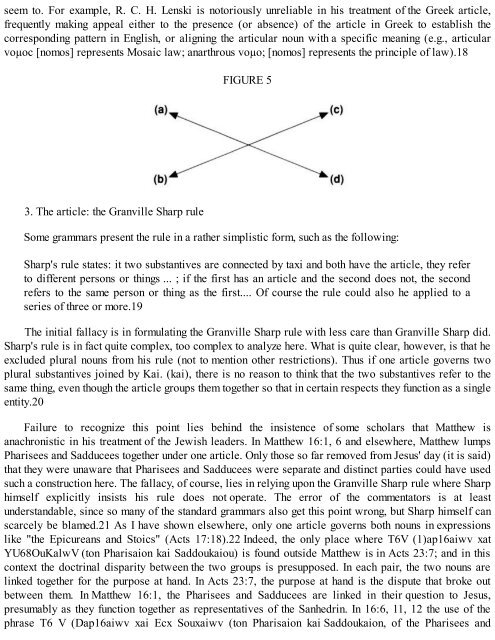Exegetical Fallacies - D. A. Carson
Exegetical Fallacies - D. A. Carson
Exegetical Fallacies - D. A. Carson
Create successful ePaper yourself
Turn your PDF publications into a flip-book with our unique Google optimized e-Paper software.
seem to. For example, R. C. H. Lenski is notoriously unreliable in his treatment of the Greek article,<br />
frequently making appeal either to the presence (or absence) of the article in Greek to establish the<br />
corresponding pattern in English, or aligning the articular noun with a specific meaning (e.g., articular<br />
voµoc [nomos] represents Mosaic law; anarthrous voµo; [nomos] represents the principle of law).18<br />
FIGURE 5<br />
3. The article: the Granville Sharp rule<br />
Some grammars present the rule in a rather simplistic form, such as the following:<br />
Sharp's rule states: it two substantives are connected by taxi and both have the article, they refer<br />
to different persons or things ... ; if the first has an article and the second does not, the second<br />
refers to the same person or thing as the first.... Of course the rule could also he applied to a<br />
series of three or more.19<br />
The initial fallacy is in formulating the Granville Sharp rule with less care than Granville Sharp did.<br />
Sharp's rule is in fact quite complex, too complex to analyze here. What is quite clear, however, is that he<br />
excluded plural nouns from his rule (not to mention other restrictions). Thus if one article governs two<br />
plural substantives joined by Kai. (kai), there is no reason to think that the two substantives refer to the<br />
same thing, even though the article groups them together so that in certain respects they function as a single<br />
entity.20<br />
Failure to recognize this point lies behind the insistence of some scholars that Matthew is<br />
anachronistic in his treatment of the Jewish leaders. In Matthew 16:1, 6 and elsewhere, Matthew lumps<br />
Pharisees and Sadducees together under one article. Only those so far removed from Jesus' day (it is said)<br />
that they were unaware that Pharisees and Sadducees were separate and distinct parties could have used<br />
such a construction here. The fallacy, of course, lies in relying upon the Granville Sharp rule where Sharp<br />
himself explicitly insists his rule does not operate. The error of the commentators is at least<br />
understandable, since so many of the standard grammars also get this point wrong, but Sharp himself can<br />
scarcely be blamed.21 As I have shown elsewhere, only one article governs both nouns in expressions<br />
like "the Epicureans and Stoics" (Acts 17:18).22 Indeed, the only place where T6V (1)ap16aiwv xat<br />
YU68OuKalwV (ton Pharisaion kai Saddoukaiou) is found outside Matthew is in Acts 23:7; and in this<br />
context the doctrinal disparity between the two groups is presupposed. In each pair, the two nouns are<br />
linked together for the purpose at hand. In Acts 23:7, the purpose at hand is the dispute that broke out<br />
between them. In Matthew 16:1, the Pharisees and Sadducees are linked in their question to Jesus,<br />
presumably as they function together as representatives of the Sanhedrin. In 16:6, 11, 12 the use of the<br />
phrase T6 V (Dap16aiwv xai Ecx Souxaiwv (ton Pharisaion kai Saddoukaion, of the Pharisees and



